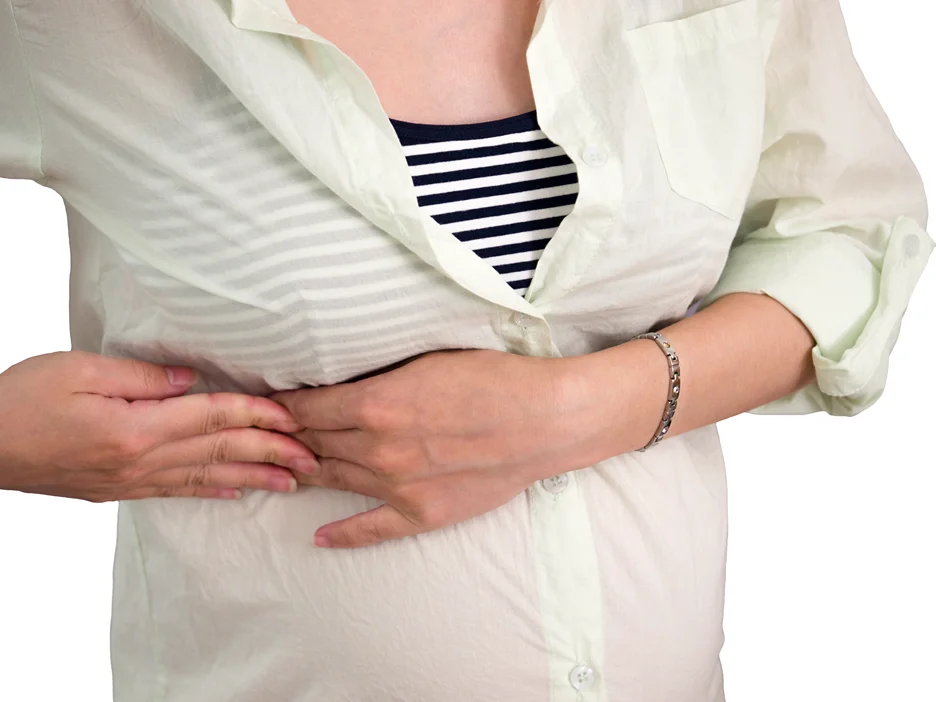That nagging pinch under your ribs and back just won’t let up. Is it a pulled muscle or something more serious? This type of pain bewilders millions. The causes range widely – from simple strains to frightening conditions.
While alarming, these symptoms typically respond well to treatment when the root issue is found. Gain insider knowledge to clear all doubts about rib aches fast.
The answers to your burning questions await – from “Could it be a rib fracture?” to “When should I request tests?” – among others.
A Quick Primer on Rib Cage Anatomy
Before diving into the causes and treatments of rib cage pain, let’s quickly review the anatomy and purpose of this important structure.
The rib cage forms a bony framework that surrounds and protects the heart, lungs, liver, and other vital organs in the thoracic cavity. It consists of:
- 12 pairs of ribs connected to the spine in the back, which they also protect
- The sternum or breastbone in front
- Costal cartilage joining the ribs to the sternum
The rib cage works with the diaphragm and intercostal muscles between each rib to control breathing and chest expansion. It also provides attachment points for the muscles of the chest, shoulders, neck, and upper back.
When one part of this interconnected network of bones, cartilage, muscles, tendons, and nerves gets irritated, you feel pain around the ribs or upper back.
Given the ribs’ proximity to vital organs, any symptoms in this area should not be ignored. Always let your doctor evaluate your discomfort if the pain doesn’t resolve on its own.
Now that we’ve reviewed the anatomy behind the rib cage, let’s explore common causes of pain and the best ways to find relief!
Why Is There an Achy Feeling Under My Ribcage?

Sharp pain under your ribs or general back discomfort can result from injuries, underlying health conditions, or simple muscle strains. To be exact, these medical conditions could be affecting the lungs, heart, pancreas, and gallbladder.
The pain can be felt on one or both sides. These are likely causes of discomfort in this area:
Pulled Intercostal Muscles
Intercostal muscles are located between each rib. Overstretching or straining the muscles may cause tearing, inflammation, and intercostal muscle pain. Symptoms include:
– Sharp pain when breathing, twisting, bending, or lying down
– Pain focused around the ribcage that may radiate to the upper back or abdomen
– Discomfort that worsens with deep breaths
Intercostal muscle strains are common and can occur from heavy lifting, intense exercise, excessive coughing, or poor posture over time. The pain is treatable at home with rest, ice, anti-inflammatory medication, and pain relief ointment.
Rib Injuries and Fractures
Direct blows to the chest or ribs can lead to bruising, fractures, or dislocations. Symptoms include:
– Sudden, severe rib cage pain at the site of injury
– Pain when inhaling or pressing on ribs
– Visible chest swelling or bruising
Rib fractures cause significant pain and difficulty breathing. Seek emergency care for serious rib injuries to rule out complications like punctured lungs. Treatment involves pain management, rib bracing, and avoiding reinjury during healing.
Arthritis
Arthritis is another frequent cause of rib and back pain. Osteoarthritis and rheumatoid arthritis can affect the small joints between the ribs and spine, leading to upper back discomfort. Signs include:
– Dull or aching pain in the rib cage and mid back
– Stiffness and decreased range of motion
– Pain worse in the morning or after inactivity
Over-the-counter anti-inflammatories, hot/cold therapy, massage, and exercise help manage arthritis pain. In severe cases, prescription medication or surgery may be necessary.
Spinal Issues
Bulging discs, spinal stenosis, or nerve compression in the thoracic spine can radiate pain to the ribs. You may experience:
– Pain between shoulder blades or ribcage
– Numbness or tingling in arms or chest
– Back pain worsened by long periods of sitting
Referred Pain
Internal organs like the pancreas, gallbladder, and kidneys can also cause pain that radiates to the rib and back area. Imaging tests like CT scans or MRIs can help diagnose underlying conditions causing this referred pain.
Intercostal Neuralgia
Inflammation of the intercostal nerves can cause burning or stabbing rib pain. Anti-seizure or antidepressant medications may help.
Cancer
Cancer affecting the ribs, chest wall, or spine can cause persistent pain. Imaging and biopsy diagnose cancer to guide treatment.
See a doctor if nerve-related upper back pain persists. Treatments range from physical therapy to epidural steroid injections or surgery for serious spinal disorders.
Should I Worry About Rib and Back Pain?
While rib aches are typically harmless, certain symptoms warrant medical evaluation to rule out serious conditions. Seek emergency care for:
– Sudden, severe chest or rib pain
– Pain accompanied by difficulty breathing
– Coughing up blood
– Unexplained weight loss along with rib pain
These alarming symptoms may signal serious medical issues like lung infections, blood clots, chest trauma, or lung cancer, among other worrying conditions.
It’s always wise to err on the side of caution and get evaluated when anything feels uncertain or off.
How Will My Doctor Diagnose Rib Cage Discomfort?
To correctly diagnose the cause of upper back and rib pain, doctors use:
Medical History Analysis
Expect questions about your symptoms, location of pain, triggers, family history, medications, and past injuries. More specific information helps narrow down potential diagnoses.
Physical Examination
Doctors will palpate the ribs and spine checking for areas of tenderness, swelling, or reduced range of motion that indicate injury or arthritis. They’ll also listen to your breathing.
Imaging Tests
X-rays can detect rib fractures or arthritis. MRI or CT scans give clear views of soft tissues like disc herniations. Ultrasounds check for issues like pulmonary embolisms.
Here are some of the tests that may be performed based on your symptoms:
- CT scan to look for lung diseases or infections that may be causing rib pain
- Ultrasound to check for fluid around the lungs or heart issues
- Bone scan if bone cancer is suspected
Bloodwork
Blood tests help confirm or rule out infections and autoimmune conditions that can cause rib pain like hepatitis or rheumatoid arthritis.
Pinpointing the origin of pain guides proper treatment. Always share your complete symptoms with your doctor. Additional tests beyond X-rays may be done to confirm the diagnosis.
How Can I Find Relief From Rib and Back Discomfort?
Once the cause is found, here are go-to treatment options to ease rib and upper back pain:
| Remedy | Benefits |
| Over-the-Counter Medication | Anti-inflammatories like ibuprofen or aspirin reduce swelling and pain. Acetaminophen blocks pain signals. Topical creams containing menthol or lidocaine provide cooling or numbing relief. |
| Heating Pads or Ice Packs | Heat relaxes tight muscles. Ice reduces inflammation. Use whichever feels best or alternate between both. |
| Physical Therapy | Stretching, exercises, and manual therapy can strengthen muscles, improve range of motion, and address poor posture contributing to pain. |
| Massage | Massage therapy releases tight tissues in the ribs, chest, and back. Just avoid deep tissue massage directly over injured or fractured ribs. |
| Home Remedy | Sleep on your back using pillows for rib support. |
| Prescription Medication | For moderate to severe pain, doctors may prescribe muscle relaxers, stronger anti-inflammatory drugs, or narcotic pain relievers. Use these with caution due to side effects. |
| Medical Procedures | Steroid injections around spinal nerves or ribs provide direct pain relief. Surgery removes compressed nerves or repairs damaged rib joints as a last resort. |
The right treatments improve mobility and make pain manageable according to your symptoms. Experiment to find your go-to methods for relief!
Know When to Seek Medical Care for Rib Discomfort
Rib and upper back pain often resolves with conservative at-home care. But call your doctor promptly if pain:
- Worsens or persists longer than 1-2 weeks
- Impairs breathing or sleep
- Follows a fall or injury to the chest or ribs
Catching serious conditions early improves prognosis and outcomes. For sudden, severe chest pain, go straight to the ER or urgent care for evaluation. Don’t downplay symptoms assuming they’ll just go away.
How Can I Prevent Ribcage and Back Pain Flare-Ups?
Reduce strain on the delicate joints and muscles around the ribs and spine by:
- Maintaining good posture when sitting and standing
- Stretching the chest, back, and sides daily
- Building core strength and improving posture by doing yoga and Pilates
- Avoiding heavy lifting by using proper form
- Quitting smoking to decrease coughing
- Managing chronic conditions contributing to pain like arthritis or osteoporosis
- Use supportive braces or taping if needed
Listen to warning twinges and avoid movements that trigger pain. Keep muscles flexible and joints mobile as you age to ward off stiffness. With some self-care, you can keep that rib cage comfortable and pain-free!
Ready to Explore Treatment Options?

If you’re still suffering from persistent rib and back discomfort, Kaly connects you to qualified local doctors for in-person or virtual consultations. Get matched with a pain management specialist or family physician tailored to your needs. Verify their experience and read reviews from real patients before booking an appointment!
Take control of hard-to-treat rib and upper back pain. Search for pain medicine doctors near you and finally get answers.
